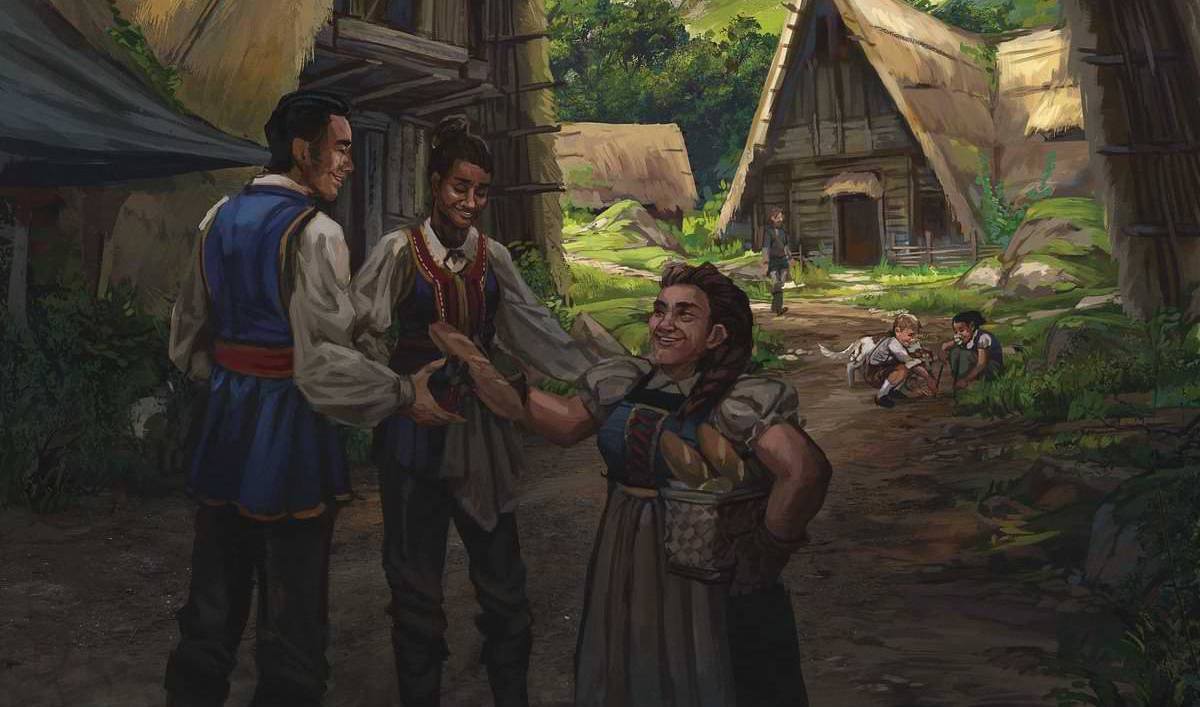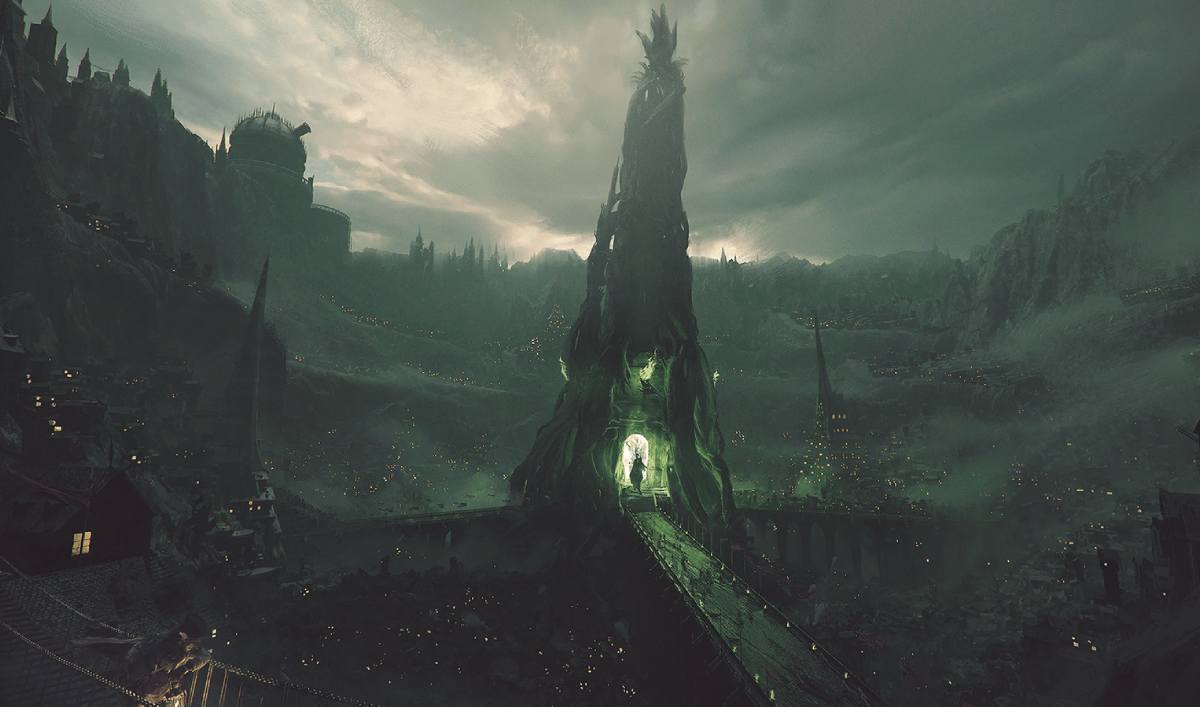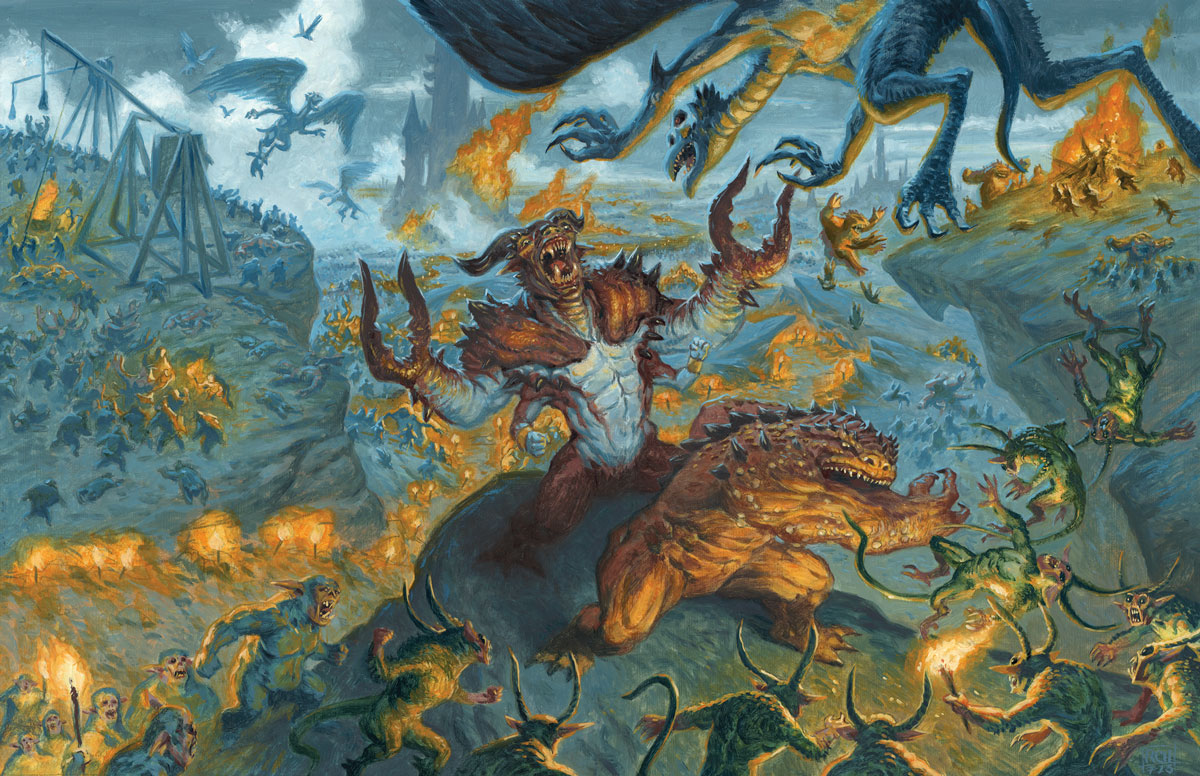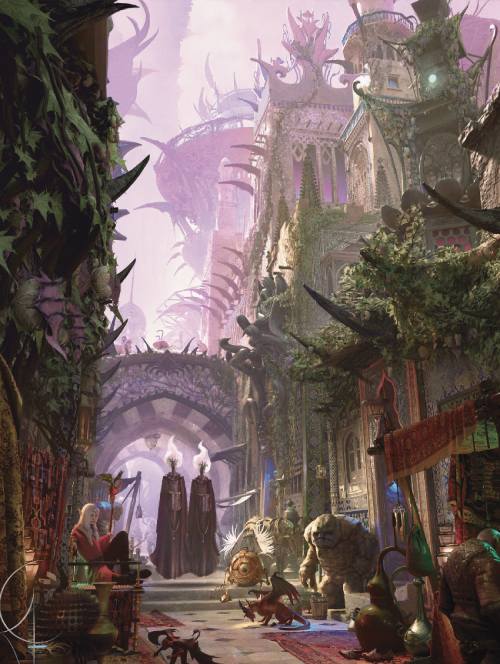Many Dungeon Masters, myself included, find that running D&D for higher-level characters can get challenging. It's difficult to pose meaningful, let alone interesting, obstacles for PCs once they cross the threshold of levels 12 to 13, and you have to get creative when it comes time to think of multiverse-ending conflicts. For higher-level adventures, like the upcoming Vecna: Eve of Ruin, you need to reframe the way you think of the game to keep your players feeling fulfilled.
If you are crafting your own high-level adventures, here are some useful tips for keeping your campaign engaging when you enter into higher-tier play.
4 Tips for Tier 4
- Use lower-tier quest structures but with more epic scope, such as armies of devils threatening an entire plane rather than Bandits threatening a village.
- Alien and exotic locations, such as the City of Brass or the Far Realm, can justify the characters having more grounded interactions even at much higher levels of play.
- Don’t threaten the characters. Threaten what they value.
- Gold and magic items become less valuable rewards. Instead, offer renown, boons, power, and influence.
What Are Tiers of Play in D&D?

D&D is broadly divided into four level ranges of play, referred to as tiers. Each tier represents a different scale at which the players engage with the world. Tiers of play are described in the 2014 Dungeon Master’s Guide, but here’s a summary:
Tier 1: Levels 1-4 - Local Heroes
Tier 1 is where your players are still figuring out their classes and deciding how to specialize their character by unlocking subclasses. Magic items are few and far between, and spells are generally cantrips and lower level. Adventures are on the scale of saving towns and villages from local threats such as Bandits or maybe an evil wizard.
Tier 2: Levels 5-10 - Heroes of the Realm
In this tier, your players move up from saving small areas to saving entire regions. Rather than fighting bandits and wizards, they might clash with dragons and necromancers with Undead armies. By now, it’s assumed the players are familiar with their classes, and it’s time to start getting into more powerful abilities; some spellcasters gain access to powerful spells such as Fireball, while some martial classes gain the ability to attack more times per action. Every character's proficiency bonus increases, as well, which is a big jump in power across the board.
Tier 3: Levels 11-16 - Masters of the Realm
Once players enter the third tier of play, they become paragons of the world they occupy, standing tall above all other heroes. The entire world's fate may rest in their hands, and their adversaries represent threats from beyond their plane, such as Aberrations from the Far Realm like Beholders or devils and demons from the Lower Planes.
The party will have the right tool in their arsenal for almost every situation, both in and out of combat. At this tier, the players will also have amassed resources beyond those of their classes; strongholds, small armies, or powerful allies will be at their disposal. Downtime might be more significant as they spend weeks, months, or even years between adventures crafting magical items or rallying people to their cause.
Tier 4: Level 17+ - Masters of the World
If, at tier 3, threats from beyond the Material Plane stood against the PCs, now the party takes the fight to them. Superheroes beyond mortal measure, tier 4 characters can do what would be considered impossible for almost anyone else. They can stand toe-to-toe with ancient dragons, invoke the power of the gods, or become immortal killing machines.
They traverse the planes, treat with angels, and broker with devils like the average person might barter with a merchant. The powers they command, and deeds they accomplish will be inscribed on the annals of history and sung by bards for centuries to come.
What to Expect Beyond Tier 2

Moving from tier 2 to tier 3 can be the most significant shift in how a campaign feels, and that is part of the reason many campaigns end around level 12 or 13. Challenging your players can become more difficult, both mechanically and narratively.
In tiers 3 and 4, your players will have access to raw destructive power and a massive array of utility options. Overworld travel can cease to be as meaningful thanks to spells such as Teleport and Word of Recall, while gathering information is made easier through the likes of Legend Lore. Martial characters will be unbreakable bulwarks, shielding the Fireball-flinging spellcasters, while classes like Rogues and Monks become blurs of speed and stealth.
When it comes to telling stories at these levels, the scope can become massive. Global politics and nation-spanning conspiracies become small-scale problems, while world-ending threats such as archliches, greatwyrms, and demon lords loom over entire planes of existence.
Your players will walk amongst figures spoken of only in legends, such as the Lady of Pain, Zariel, or even Tiamat herself.
Changing the Challenges

But how do you go about running campaigns at higher levels? Well, for all my talk of how different it is from lower-level play, one of the best pieces of advice I can give is to dress low-level adventure structures up in high-level presentation.
Let’s take a very simple tier 1 quest structure:
The small town of Exampleton, between the banks of the River Placeholder and Plot Hook Forest, is under threat. The warlord Beebee Eegee and his Bandits have been terrorizing the village from their camp hidden deep within the forest. The characters must travel through the dangerous forest, fend off Giant Spiders and Dire Wolves, infiltrate the camp, and slay Beebee.
This hook is fairly standard fare for low-level play and likely something you wouldn’t see outside of tier 1. Or is it?
Let’s take the same hook, or even better, the same text, and dress it up as a tier 4 questline:
The plane of Exampliar, between the astral banks of the River Styx and bordering on the Feywild, is under threat. The devil, Eind Baws, and her Fiends have been terrorizing the plane from their fortress deep within the Feywild. The characters must travel through the Ethereal Plane into the Feywild, fend off giants and dragons, infiltrate the fortress, and slay Eind.
The structure is nearly identical but is now scaled up as a suitable premise for high-level player characters. By taking low-level structures and upscaling them, you can build out suitable high-level adventure lines; the dungeon filled with gnolls within a shattered castle becomes a dungeon filled with demons within a shattered demiplane. Sailing the sea to a desert island to stop a yuan-ti ritual becomes spelljamming the Astral Sea to the remains of a dead god to stop a githyanki ritual. Same structure, bigger scope.
Same Structure, Unusual Locales

Speaking of scope, upscaling your locales can also make for fun tier 3 and 4 play. Even in the higher (and lower) planes of existence, there are towns and cities: the City of Brass in the Elemental Plane of Fire; Empyrea, the capital city of Mertion, the Platinum Heaven, the fifth layer of Mount Celestia; or even Sigil, the City of Doors.
Here, the players can rub shoulders with devils and demons, Celestials and Elementals, just like they used to rub shoulders with butchers, bakers, and candlestick makers back at level 1. These strange yet familiar settings can give your players space to explore being higher level without feeling quite so disconnected from those around them as they might in a more mundane city.
In my article on exploration design, I mentioned how I was running a 20th-level arc of my campaign, during which my players explored my setting's version of the drow capital of Menzoberranzan. I’ve been using the above philosophy to great effect as my players have felt powerful yet humbled as they rub shoulders with some of the most powerful drow in the Underdark.
We’re talking priestesses who can call on Lolth for profane miracles at a whim and where dark paladins patrol the streets enforcing the Spider Queen's laws. By making the city feel alien and disconnected from the world they know, hostile at every turn, and ruled over by individuals who command dark and disturbing amounts of power, my players have found new challenges to test their powers against.
Finally, there’s the matter of stakes and what the players are fighting for, or against, for that matter. It can start to feel like there’s nothing you can do to really threaten the PCs as they become able to recover from any blow, counter any spell, or simply become indestructible. However, just because the characters are invincible, that doesn’t mean those around them are.
The people living in the towns and cities the players have visited, the friends and allies they’ve made on their quests, or even just the common folk they feel a sense of connection to are still just as fragile. There’s a concept in character design called Knife Theory; a knife is anything in a character's backstory that the DM can use against them. This can be a loved one, a valued possession, or even a special location. At high levels, these proverbial knives become indispensable, so as a DM for tier 3 and 4 play, make sure you keep all your knives sharpened and close at hand because they’re going to be your main weapons.
A classic example of this approach is in the best way to use a Tarrasque. For a CR 30 monster, the Tarrasque isn’t that scary, and a level 20 or lower party could easily take one on with little risk.
But that assumes you’re deploying a Tarrasque as a head-on fight with the PCs. Instead, put the Tarrasque on a rampage directly toward the city where the party’s home base is, or where one of the PC’s families lives, or if you want to make the D in DM stand for Diabolical, where that adorable Goblin they rescued at level 3 now lives. It’s now no longer about killing the Tarrasque; it’s about killing the Tarrasque before it destroys the city where Boblin the Goblin lives!
There are stakes now that transcend the PCs dying; the knives are out, and the players are fighting against the clock, against a force of nature. All the level 20 abilities in the world won’t matter if they take too long, and even if they do succeed, at what cost?
Victory in D&D isn’t always about the party walking away alive—sometimes, there’s so much more at stake.
Level 20 and Beyond
While it’s fair to say that running D&D as a Dungeon Master can become increasingly difficult the higher the party’s level goes, hopefully these tips help you avoid tiering your hair out over tier 4 play.
If I were to summarize my advice into a single point, it would be to remember that high-level play can always be approached much in the same way as low-level play but dressed up with bigger and more dramatic styling. And if you need some inspiration for higher-level play, don’t forget to check out Vecna: Eve of Ruin, releasing May 21. This adventure for 10th- to 20th-level characters will take your party to iconic locations across the multiverse as they race to stop Vecna the lich-god from completing a multiverse-destroying ritual!

Davyd is a moderator for D&D Beyond. A Dungeon Master of over fifteen years, he enjoys Marvel movies, writing, and of course running D&D for his friends and family, including his wife Steph and his daughter Willow (well, one day). They live with their two cats Khatleesi and Mollie in the south of England.








-
View User Profile
-
Send Message
Posted May 10, 2024Throw more at them if the encounters are to easy. The size of the party, chemistry of the builds, and power gaming focus makes it impossible for a one size fits all formula to provide the exact right challenge for every possible group.
The DM can always kill the party, the challenge is to not TPK them while sending hoards of dangerous foes to push the party to the limit, sometimes. Other times the party should get the fun of crushing your encounter to your surprise.
-
View User Profile
-
Send Message
Posted May 15, 2024Been DMing since 2013, including multiple high-lvl campaigns, and I almost entirely agree with your analysis @MercenaryGod
I will add a warning for new DMs against becoming enamoured with your own custom BBEG, and either making them too strong or make the game too much about them.
Also giving them too many abilities and/or spells is a common issue. Stick to what you actually want, and cut down what isn't necessary.
Adding traps, environmental challenges (which aren't the same thing as hazards- think cover, heights and distances), lieutenants and a dirty trick or two can be more than enough, and make a much more engaging game.
Also, most of the advice in the article is actually pretty terrible.
Higher-level play SHOULDN'T be the same as lower levels but with higher stakes and stronger baddies, that's awful. It should be much more about finding your own way of doing things (since you're less limited by the world around you), enemies that can't normally be defeated by just swords and fire (a gimmick boss every now and then is totally fine), having villains that know and care about you and are proactive... There's so much to it than just "same but bigger".
(Threatening beloved NPCs is ok, but it can't be the main/only threat. The PCs need to be in some danger for most campaigns.)
-
View User Profile
-
Send Message
Posted May 15, 2024It should be much more about finding your own way of doing things (since you're less limited by the world around you), enemies that can't normally be defeated by just swords and fire (a gimmick boss every now and then is totally fine), having villains that know and care about you and are proactive... There's so much to it than just "same but bigger".
Why wait until level 10 before introducing these things?
-
View User Profile
-
Send Message
Posted May 16, 2024Of course you don't have to wait, but these are the sort of challenges that simply work better at higher levels.
A simple, linear dungeon doesn't work well when the PCs have dimension door, etherealness, etc., just like permanently-invisible enemies don't work well before players have a way to solve or mitigate that problem.
A fight against enemies which are on several different elevations might be hard and frustrating at level 2, fun and challenging at level 7 with fly and spider climb, and trivial at level 11 with scatter.
An enemy with, say, a vulnerability that changes each round (and perhaps immunity to all other damage) is only a good foe when the players have several different damage options.
Higher level means more resources, so challenges that require more resources (or reward creative uses of complex resources, such as using powerful noncombat spells) are in order.
Sure, you can and should reward creative thinking at lower levels, but lower level parties don't have the tools for a lot of things.
As for proactive BBEGs, low level parties might find it hard to survive, while higher level ones can find solutions for stuff like enemies attacking during rests (leumond's tiny hut) or a villain using dream to cause nightmares every night.
Also, if your BBEG is, say, a lich, if they become aware of the PCs and seek to destroy them at level 3, they can. Easily. That's no fun. A weaker villain with less resources who is hunting for the PCs is totally fair, but if your campaign revolves around a specific bad guy it's not the same.
-
View User Profile
-
Send Message
Posted May 16, 2024I don't think I understand your objection to the advice in the article. Similar stories with higher stakes against more challenging enemies is what one should expect as the party goes against higher tier creatures. Players should be finding creative solutions to problems at every tier, and DMs should be giving them encounters with a variety of different challenges. Sadly it is easy for a DM or even a professional module writer to fall into the habit of having the same terrain and other features for most of the encounters, while just using higher CR monsters. But that isn't recommended in the article.
Small fires can be interesting obstacles at tier 1. Bigger fires at tier 2. Lava at tier 3. Sometimes these are just features and might actually help the party if they get creative in using them. Other times it can provide big advantages to a creature that is immune to fire.
In tier 1 archers behind a half wall on top of a hill with a long path to the top are brutal, so be sure to provide spots with cover on the way up. In tier two difficult terrain and better archers adds to the fun, or just remove the spots with cover. In tier 3 you need to provide high stealth ambush locations because they can travel the distance of an archer's attack through the air. Or use the player's tactics against flying creatures against them. Things like web, entangle, or a held earth bind spell can be fun way to counter their abilities.
The same scaling can be used for other types of hazards, traps, terrain features, and lighting conditions. Every group fights with a different style, dynamic, and focus on power gaming. The DM can observe their tendencies and occasionally create an encounter designed to counter their favorite tactics. Trying to list all the possible techniques would require a few new DMG to be published.
Starting at level 10 is rough even for very experienced players and DMs as they have so many abilities to choose to use, and they haven't had the time to learn the preferences of their party or the style of the DM. Which is why I'm going to run Vecna by speeding my party through the lower levels with the players getting two milestone levels for each story arc. Most story arcs will have one adventuring day 5-10 encounters in tier two. They will also occasionally have a once per long rest fight where they can have fun unleashing all their power knowing they are about to take a long rest.
-
View User Profile
-
Send Message
Posted May 16, 2024What would have happened if Arya Stark had all of the abilities of a Faceless at the start of the series? She'd just assassinate every Lannister.
And if John Snow had the power of Marvel's Thor, the Battle of the Bastards wouldn't have been very interesting.
Conversely, let Bilbo Baggins be the one to try and collect the Infinity Stones, and you'd be in a bit of trouble, since some of them are in space.
Different types of stories call for different power levels.
That's why, for example, the Night King changes everything in GoT: He's a threat of a different type, and no amount of swords and intrigue will matter against him.
-
View User Profile
-
Send Message
Posted Jun 3, 2024Always ban wish
-
View User Profile
-
Send Message
Posted Jun 3, 2024Yay. But give boblin a magic shield first (to keep him alive)
-
View User Profile
-
Send Message
Posted Jun 3, 2024Boblin will live. If you give him magic plate armor.
-
View User Profile
-
Send Message
Posted Jun 3, 2024Thank you, I gave him a magical artifact that takes the form of his exclusive hat.
-
View User Profile
-
Send Message
Posted Jun 5, 2024If Arya starts out level 20, so do the Lannister's. And they would have vast amounts of magical defenses as well as henchman and the like to defend against such attacks.
Starks vs Lannister's work at every level of play as long as the CR/Difficulties are a good match.
No story can overcome a level 20 hero fighting against a level 5 villain surrounded by a few lower level flunkies.
-
View User Profile
-
Send Message
Posted Jun 5, 2024This is sooo true
-
View User Profile
-
Send Message
Posted Jun 5, 2024Like why would a level 15+ character even bother trying to fight an enemy under 10th level, like just leave it your lackeys.